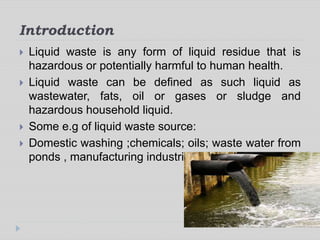A Biased View of Reclaim Waste
A Biased View of Reclaim Waste
Blog Article
Our Reclaim Waste Statements
Table of Contents4 Simple Techniques For Reclaim WasteFacts About Reclaim Waste RevealedFascination About Reclaim WasteReclaim Waste - QuestionsA Biased View of Reclaim Waste
Explore the types, events, and forms of liquid waste. Domestic sewer waste refers to the waste and items from a residential septic system. This sort of waste is produced by people in residences, schools, and other buildings. This only consists of septic tanks that have a drain area. The correct management and disposal of domestic sewage waste need fluid waste to be moved to a sewer therapy plant where the correct techniques and equipment are put on detoxify and take care of waste.
Commercial waste usually consists of possible hazards, such as flammable products or a combination of liquid and solid waste items, and calls for an advanced and comprehensive disposal process. The disposal of industrial waste typically includes the filtering of waste before transportation to make sure secure and appropriate disposal. Hazardous waste is developed from results and drainage of industrial processes and production.
This type of waste can not use the exact same sewer administration transport or processes as septic or industrial liquids. The industrial waste monitoring process requires the examination and screening of fluid waste before it goes through the disposal process (liquid waste disposal melbourne). Drainage waste is the liquid waste that originates from drainage and excess stormwater in highly populated areas or cities
Runoff waste can create contamination and flooding otherwise handled properly. Discover more regarding drain cleaning and waste monitoring. Making certain proper waste administration can avoid catastrophes and decrease environmental injury. Both individuals in residential settings and professionals in commercial or manufacturing markets can profit from comprehending the procedures and regulations of liquid waste monitoring.
The 10-Minute Rule for Reclaim Waste
Call PROS Providers today to find out about our waste management and disposal services and the proper methods to care for the liquid waste you create.
(https://www.twitch.tv/reclaimwaste1/about)This supposed 'wastewater' is not only a vital source yet, after treatment, will be launched to our land, waterways or the ocean. Utilized water from toilets, showers, baths, kitchen area sinks, washings and commercial procedures is recognized as wastewater.

water made use of to cool machinery or clean plant and equipment). you could try these out Stormwater, a form of wastewater, is drainage that streams from agricultural and metropolitan areas such as roofing systems, parks, gardens, roads, courses and rain gutters into stormwater drains pipes, after rainfall. Stormwater streams unattended directly to regional creeks or rivers, ultimately getting to the ocean.
The 3-Minute Rule for Reclaim Waste
In Queensland, a lot of wastewater is dealt with at sewer treatment plants. Wastewater is carried from domestic or commercial sites via a system of sewers and pump stations, referred to as sewage reticulation, to a sewer therapy plant. City governments build, preserve and operate most sewer treatment plants. Operators are licensed under the Environmental Defense Act 1994 to discharge treated wastewater at an acceptable environmental criterion into rivers.
The Division of Natural Resources suggests city governments regarding handling, operating and maintaining sewerage systems and treatment plants. In unsewered areas, city governments may require householders to set up specific or house sewage treatment systems to treat domestic wastewater from commodes, kitchen areas, shower rooms and laundries. The Department of Natural Resources authorizes the use of household systems when they are verified to be efficient.
In some new neighborhoods, therapy of some stormwater to remove clutter, sand and gravel has actually begun using gross contaminant catches. Wastewater therapy happens in four phases: Gets rid of solid issue.
Uses tiny living organisms knows as micro-organisms to damage down and remove continuing to be dissolved wastes and great fragments. Micro-organisms and wastes are incorporated in the sludge.
Some Known Details About Reclaim Waste
Nutrient elimination is not offered at all sewage treatment plants due to the fact that it needs costly specialised tools. Clear fluid effluent generated after treatment may still contain disease-causing micro-organisms - liquid waste removal.

The majority of wastewater flows into the sewerage system. Under the Act, neighborhood federal governments provide approvals and licences for eco appropriate tasks (Ages) involving wastewater launches that could have a local influence.
Some Known Incorrect Statements About Reclaim Waste
Otherwise, samples are taken for laboratory analysis. Usually many examinations are required to develop the degrees of each of the different contaminants such as oils, hefty metals and chemicals in water. Tracking offers factual info regarding water top quality and can confirm that permit problems are being fulfilled. The details obtained with surveillance provides the basis for making water high quality choices.
Report this page